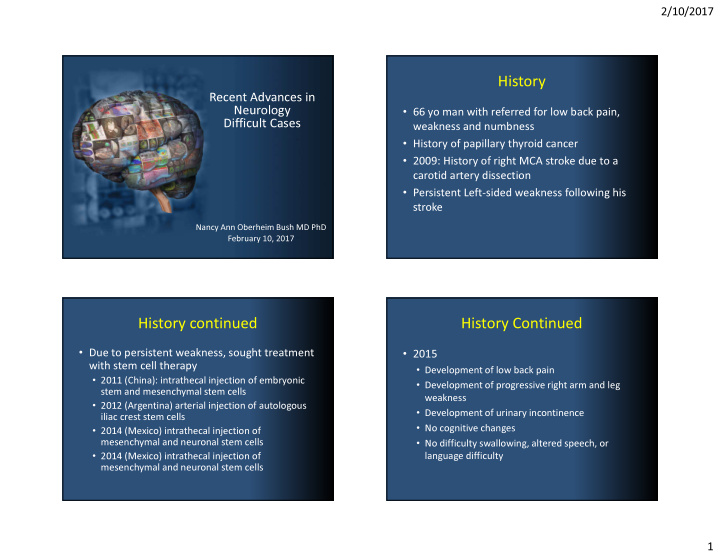



2/10/2017 History Recent Advances in Neurology • 66 yo man with referred for low back pain, Difficult Cases weakness and numbness • History of papillary thyroid cancer • 2009: History of right MCA stroke due to a carotid artery dissection • Persistent Left-sided weakness following his stroke Nancy Ann Oberheim Bush MD PhD February 10, 2017 History continued History Continued • Due to persistent weakness, sought treatment • 2015 with stem cell therapy • Development of low back pain • 2011 (China): intrathecal injection of embryonic • Development of progressive right arm and leg stem and mesenchymal stem cells weakness • 2012 (Argentina) arterial injection of autologous • Development of urinary incontinence iliac crest stem cells • No cognitive changes • 2014 (Mexico) intrathecal injection of mesenchymal and neuronal stem cells • No difficulty swallowing, altered speech, or • 2014 (Mexico) intrathecal injection of language difficulty mesenchymal and neuronal stem cells 1
2/10/2017 Investigations Examination MRI brain with and without contrast • Well appearing man in no acute distress in a wheelchair. T1-weighted with contrast T2-weighted FLAIR • Mental status : normal cognition and language. He has left hemi neglect. • Cranial nerves: upper motor neuron left facial droop • Motor : spastic left hemiparesis with a paretic right leg. • Reflexes: knee jerks were 3+ bilaterally, clonus in the ankles bilaterally. Plantar responses were extensor bilaterally. • Coordination: normal bilaterally in arms • Sensory: marked hyperesthesia with paresthesias in the left arm and leg with a T4 sensory level on right. No vibratory sensation in the legs. Question 1 Investigations MRI spine with contrast What is the least likely etiology of this lesion? 65% A. A) Myxopapillary Ependymoma B. B) Glioblastoma C. C) Intramedullary metastasis 17% 10% 8% D. D) Lymphoma 2
2/10/2017 Intramedullary Lesions Ependymomas • Spinal cord tumors can be within or adjacent • Ependymoma to the spinal cord • Myxopapillary ependymoma • Primary spinal cord tumors account for 2-4% • Subependymoma of all primary CNS tumors • Anaplastic ependymoma • 1/3 of Spinal cord tumor are intramedullary • Ependymomas • Astrocytoma • Metastases Ependymoma Myxopapillary ependymoma • Commonly arise in the lumbosacral spinal cord • Most common intramedullary tumors in adults and filum terminale • Peak age 30-40 years • median age at diagnosis is 35 to 37 years • Presentation with localized pain, followed by • Present most commonly with pain, neurologic neurologic deficits (occur centrally within the deficits less common cord, expanding it symmetrically as they grow) • propensity for seeding of the neuroaxis, complete • Tumor-associated cyst (syrinx) is common brain and spine MR imaging and cerebrospinal fluid analysis should be done • Generally enhance intensely on MRI • Treatment: gross total resection, if partial • Treatment: gross total resection, if partial resection, radiation resection, consider treatment with radiation 3
2/10/2017 Astrocytoma Metastases • Occur throughout the spinal cord • Rare • ½ are pilocytic astrocytomas • ½ are associated with lung cancer. – well circumscribed and low grade with nonaggressive – Breast cancer, renal cell carcinoma, Iymphoma, and clinical behavior. melanoma – enhance intensely with gadolinium • ½ are infiltrative astrocytomas • Usually observed in patients with widespread – nonencapsulated lesions that enhance minimally or metastatic disease. heterogeneously on MRI • Typically present with weakness, numbness, and – 1/3 are high grade: anaplastic astrocytoma or GBM • 50% of the high grade tumors have the H3K27M mutations pain • Treatment: surgical resection, followed by radiation +/- • Treatment: fractionated radiation chemotherapy in high grade. Gross Image from Biopsy Pathology H&E MIB-1 Olig2 SOX2 4
2/10/2017 Question 2 Pathology What is the pathologic diagnosis? A. Glioblastoma 43% 41% B. Glioproliferative Lesion C. Anaplastic Astrocytoma D. Pilocytic Astrocytoma 12% 4% Next Generation Sequencing Further investigations • Next generation sequencing: no cancer- associated genetic aberrations detected • Short tandem repeat DNA fingerprinting analysis • 62% of the cells contained non-host DNA 5
2/10/2017 Pathology Treatment • Glioproliferative lesion • Fractionated Radiation therapy was given to 48.6 Gy to the mid C-spine through sacrum • Improvement in Pain • No improvement in Neurologic function Post-treatment imaging Clinical Implications • Primary spinal cord tumors account for 2-4% of all primary CNS • 1/3 of Spinal cord tumor are intramedullary and include ependymomas, astrocytomas, and metastases • Stem-Cell therapy is current being used in much of the world for therapy in an unregulated fashion • Patients should show caution with using these treatments • There is promise for stem cell therapy, but it should continue to be studied in a controlled manner 6
2/10/2017 References Nicholas • Susan Chang, Berkowitz Al. Et al. Glioproliferative Lesion of the Spinal Cord as a Butowski, MD MD Complication of “Stem-Cell Tourism. N England J Med. 2016 Jul Clinical Neuro-Oncology Program 14;375(2):196-8. and Brain Tumor Research Center • Bowman M, Racke M, Kissel J, Imitola J. Responsibilities of health care 400 Parnassus Avenue A808 Jennifer professionals in counseling and educating patients with incurable Clarke, MD San Francisco, CA 94143 neurological diseases regarding “stem cell tourism”: caveat emptor. JAMA Phone: (415) 353-2966Fax: (415) 353-2167 Neurol 2015;72:1342-1345 http://neurosurgery.ucsf.edu/index.php/brain_tumor_center.html • Amariglio N, Hirshberg A, Scheithauer BW, et al. Donor-derived brain Jennie Taylor, MD tumor following neural stem cell transplantation in an ataxia telangiectasia patient. PLoS Med2009;6:e1000029-e1000029 • Fox IJ, Daley GQ, Goldman SA, et al. Use of differentiated pluripotent stem cells as replacement therapy for treating Nancy Ann Oberheim- Bush MD, PhD disease.Science 2014;345:127391-127391 Mitchel Berger, MD Michael Philip Theodosopoulos, Manish Aghi, McDermott, MD MD MD, PhD 7
Recommend
More recommend